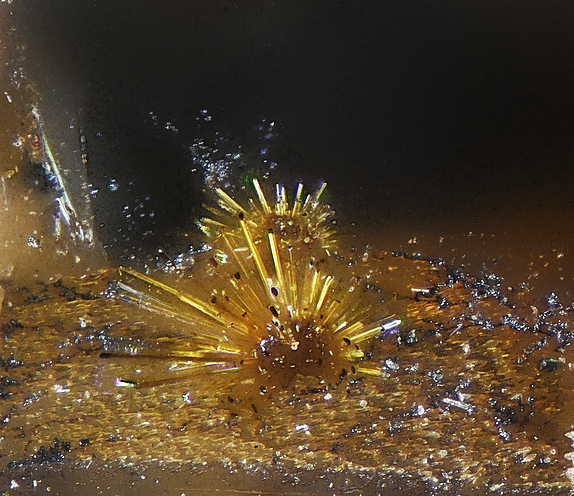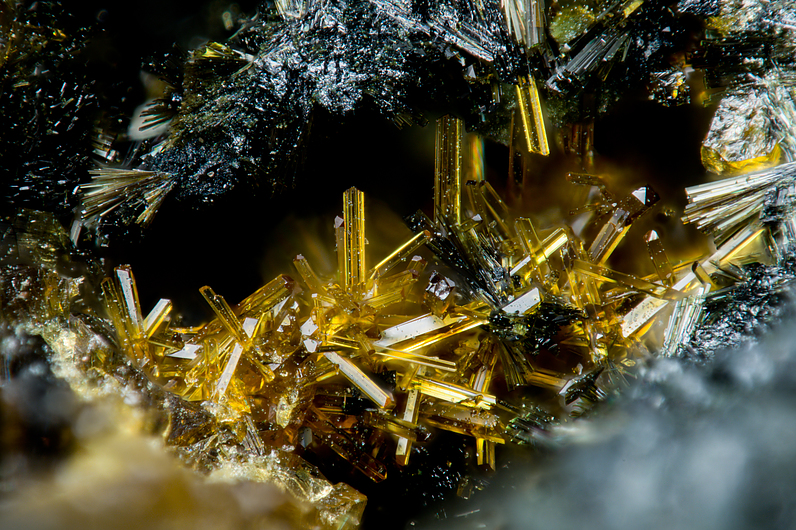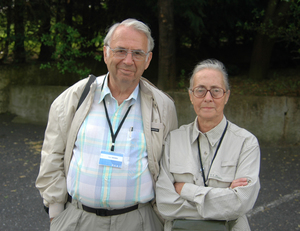Whitmoreite
A valid IMA mineral species
This page is currently not sponsored. Click here to sponsor this page.
About Whitmoreite
Formula:
Fe2+Fe3+2(PO4)2(OH)2 · 4H2O
Colour:
Yellow-brown, green-brown
Lustre:
Sub-Adamantine, Vitreous
Hardness:
3
Specific Gravity:
2.87
Crystal System:
Monoclinic
Member of:
Name:
Named in 1974 by Paul Brian Moore, Anthony Robert Kampf, and A. J. Irving in honor of Robert Whitmore [b. September 20, 1936 - May 7, 2011], mineral collector of Weare, New Hampshire (USA) and owner of the Palermo Pegmatite localities in Groton.
Isostructural with:
Arthurite Group. The phosphate analogue of Bendadaite. The mineral ranges from golden-yellow to dark red-brown. The mineral is mostly found as open crystal sprays often with a central sphere-like nucleous and ordinarily lighter than the the sprays.
Unique Identifiers
Mindat ID:
4281
Long-form identifier:
mindat:1:1:4281:5
GUID
(UUID V4):
(UUID V4):
f4a44260-b5e6-4153-8659-01346c2589eb
IMA Classification of Whitmoreite
Approved
Approval year:
1974
First published:
1974
Classification of Whitmoreite
8.DC.15
8 : PHOSPHATES, ARSENATES, VANADATES
D : Phosphates, etc. with additional anions, with H2O
C : With only medium-sized cations, (OH, etc.):RO4 = 1:1 and < 2:1
8 : PHOSPHATES, ARSENATES, VANADATES
D : Phosphates, etc. with additional anions, with H2O
C : With only medium-sized cations, (OH, etc.):RO4 = 1:1 and < 2:1
42.11.20.1
42 : HYDRATED PHOSPHATES, ETC.CONTAINING HYDROXYL OR HALOGEN
11 : (AB)3(XO4)2Zq·xH2O
42 : HYDRATED PHOSPHATES, ETC.CONTAINING HYDROXYL OR HALOGEN
11 : (AB)3(XO4)2Zq·xH2O
19.13.6
19 : Phosphates
13 : Phosphates of Fe alone
19 : Phosphates
13 : Phosphates of Fe alone
Mineral Symbols
As of 2021 there are now IMA–CNMNC approved mineral symbols (abbreviations) for each mineral species, useful for tables and diagrams.
Please only use the official IMA–CNMNC symbol. Older variants are listed for historical use only.
Please only use the official IMA–CNMNC symbol. Older variants are listed for historical use only.
| Symbol | Source | Reference |
|---|---|---|
| Whm | IMA–CNMNC | Warr, L.N. (2021). IMA–CNMNC approved mineral symbols. Mineralogical Magazine, 85(3), 291-320. doi:10.1180/mgm.2021.43 |
| Whm | Whitney & Evans (2010) | Whitney, D.L. and Evans, B.W. (2010) Abbreviations for names of rock-forming minerals. American Mineralogist, 95, 185–187 doi:10.2138/am.2010.3371 |
Physical Properties of Whitmoreite
Sub-Adamantine, Vitreous
Transparency:
Transparent, Translucent
Colour:
Yellow-brown, green-brown
Hardness:
3 on Mohs scale
Tenacity:
Brittle
Cleavage:
Imperfect/Fair
Fair on {100}
Fair on {100}
Density:
2.87(1) g/cm3 (Measured) 2.85 g/cm3 (Calculated)
Optical Data of Whitmoreite
Type:
Biaxial (-)
RI values:
nα = 1.670 - 1.676 nβ = 1.712 - 1.725 nγ = 1.745 - 1.850
2V:
Measured: 60° to 65°, Calculated: 62°
Max Birefringence:
δ = 0.075 - 0.174

Image shows birefringence interference colour range (at 30µm thickness)
and does not take into account mineral colouration.
and does not take into account mineral colouration.
Surface Relief:
High
Dispersion:
weak
Pleochroism:
Visible
Comments:
X=Y= light greenish brown to yellow
Z= dark greenish brown to yellowish green
Z= dark greenish brown to yellowish green
Chemistry of Whitmoreite
Mindat Formula:
Fe2+Fe3+2(PO4)2(OH)2 · 4H2O
Elements listed:
Common Impurities:
Mn
Crystallography of Whitmoreite
Crystal System:
Monoclinic
Class (H-M):
2/m - Prismatic
Space Group:
P21/b
Setting:
P21/c
Cell Parameters:
a = 10 Å, b = 9.73(2) Å, c = 5.471(8) Å
β = 93.8°
β = 93.8°
Ratio:
a:b:c = 1.028 : 1 : 0.562
Unit Cell V:
531.16 ų (Calculated from Unit Cell)
Z:
2
Morphology:
Uncommon as pseudo-orthorhombic crystals, prismatic to acicular with chisel shape terminations. In fans, radiating sprays or balls. Observed forms include: a{100}, m{110}, s{011}, t{021}, and u{112}.
Twinning:
Common by reflection on {100}
Crystal Structure
Load
Unit Cell | Unit Cell Packed
2x2x2 | 3x3x3 | 4x4x4
Unit Cell | Unit Cell Packed
2x2x2 | 3x3x3 | 4x4x4
Show
Big Balls | Small Balls | Just Balls | Spacefill
Polyhedra Off | Si Polyhedra | All Polyhedra
Remove metal-metal sticks
Big Balls | Small Balls | Just Balls | Spacefill
Polyhedra Off | Si Polyhedra | All Polyhedra
Remove metal-metal sticks
Display Options
Black Background | White Background
Perspective On | Perspective Off
2D | Stereo | Red-Blue | Red-Cyan
Black Background | White Background
Perspective On | Perspective Off
2D | Stereo | Red-Blue | Red-Cyan
View
CIF File Best | x | y | z | a | b | c
CIF File Best | x | y | z | a | b | c
Rotation
Stop | Start
Stop | Start
Labels
Console Off | On | Grey | Yellow
Console Off | On | Grey | Yellow
Data courtesy of the American Mineralogist Crystal Structure Database. Click on an AMCSD ID to view structure
| ID | Species | Reference | Link | Year | Locality | Pressure (GPa) | Temp (K) |
|---|---|---|---|---|---|---|---|
| 0000411 | Whitmoreite | Moore P B, Kampf A R, Irving A J (1974) Whitmoreite, FeFe2(OH)2(H2O)4[PO4]2, a new species: Its description and atomic arrangement American Mineralogist 59 900-905 |  | 1974 | 0 | 293 |
CIF Raw Data - click here to close
X-Ray Powder Diffraction
Powder Diffraction Data:
| d-spacing | Intensity |
|---|---|
| 10.05 Å | (10) |
| 7.01 Å | (7) |
| 4.98 Å | (7) |
| 4.21 Å | (7) |
| 2.802 Å | (7) |
| 4.42 Å | (6) |
| 3.476 Å | (5) |
Geological Environment
Paragenetic Mode(s):
| Paragenetic Mode | Earliest Age (Ga) |
|---|---|
| Stage 4b: Highly evolved igneous rocks | >3.0 |
| 34 : Complex granite pegmatites | |
| Stage 7: Great Oxidation Event | <2.4 |
| 47a : [Near-surface hydration of prior minerals] | |
| 47c : [Carbonates, phosphates, borates, nitrates] | |
| 47e : [Vanadates, chromates, manganates] |
Geological Setting:
Secondary mineral in complex zoned granitic pegmatites.
Type Occurrence of Whitmoreite
General Appearance of Type Material:
Acicular crystals with a length to width ratio of 5 to 10, and a length of 0.1 to 2.0 mm. The crystals form fans and sprays. Occasionally as isolated individuals. Typically occurs as a small spheric core from which small, thin crystals radiate.
Place of Conservation of Type Material:
National Museum of Natural History, Washington, D.C., USA, 128069.
Geological Setting of Type Material:
Pegmatite. Hydrothermal alteration of triphylite.
Associated Minerals at Type Locality:
Reference:
Moore, P.B., Kampf, A.R. and Irving, A.J. (1974) Whitmoreite, Fe2+Fe3+2(OH)2(H2O)4[PO4]2, a new species: Its description and atomic arrangement. American Mineralogist: 59: 900-905.
Synonyms of Whitmoreite
Other Language Names for Whitmoreite
Relationship of Whitmoreite to other Species
Member of:
Other Members of this group:
| Arthurite | CuFe3+2(AsO4)2(OH)2 · 4H2O | Mon. 2/m : P21/b |
| Bendadaite | Fe2+Fe3+2(AsO4)2(OH)2 · 4H2O | Mon. 2/m : P21/b |
| Cobaltarthurite | (Co,Mg)Fe3+2(AsO4)2(OH)2 · 4H2O | Mon. 2/m : P21/b |
| Earlshannonite | Mn2+Fe3+2(PO4)2(OH)2 · 4H2O | Mon. 2/m : P21/b |
| Kunatite | CuFe3+2(PO4)2(OH)2 · 4H2O | Mon. 2/m : P21/b |
| Ojuelaite | ZnFe3+2(AsO4)2(OH)2 · 4H2O | Mon. 2/m : P21/b |
| UKI-2006-(PO:AlCuFeH) | Fe2+Al3+2(PO4)2(OH)2 · 4H2O | |
| UM2006-27-PO:FeHZn | ZnFe3+2(PO4)2(OH)2 · 4H2O | Mon. |
Common Associates
Associated Minerals Based on Photo Data:
| 17 photos of Whitmoreite associated with Rockbridgeite | Fe2+Fe3+4(PO4)3(OH)5 |
| 13 photos of Whitmoreite associated with Beraunite | Fe3+6(PO4)4O(OH)4 · 6H2O |
| 12 photos of Whitmoreite associated with Strunzite | Mn2+Fe3+2(PO4)2(OH)2 · 6H2O |
| 10 photos of Whitmoreite associated with Mitridatite | Ca2Fe3+3(PO4)3O2 · 3H2O |
| 10 photos of Whitmoreite associated with Ferristrunzite | Fe3+Fe3+2(PO4)2(OH)3 · 5H2O |
| 9 photos of Whitmoreite associated with Stewartite | Mn2+Fe3+2(PO4)2(OH)2 · 8H2O |
| 7 photos of Whitmoreite associated with Strengite | FePO4 · 2H2O |
| 6 photos of Whitmoreite associated with Laueite | Mn2+Fe3+2(PO4)2(OH)2 · 8H2O |
| 6 photos of Whitmoreite associated with Quartz | SiO2 |
| 5 photos of Whitmoreite associated with Phosphosiderite | FePO4 · 2H2O |
Related Minerals - Strunz-mindat Grouping
| 8.DC. | Ianbruceite | Zn2(AsO4)(OH) · 3H2O |
| 8.DC. | Césarferreiraite | Fe2+ Fe3+2(AsO4)2(OH)2 · 8H2O |
| 8.DC. | Ferrivauxite | Fe3+Al2(PO4)2(OH)3 · 5H2O |
| 8.DC.05 | Nissonite | Cu2Mg2(PO4)2(OH)2 · 5H2O |
| 8.DC.07 | Euchroite | Cu2(AsO4)(OH) · 3H2O |
| 8.DC.10 | Legrandite | Zn2(AsO4)(OH) · H2O |
| 8.DC.12 | Strashimirite | Cu8(AsO4)4(OH)4 · 5H2O |
| 8.DC.15 | Arthurite | CuFe3+2(AsO4)2(OH)2 · 4H2O |
| 8.DC.15 | Earlshannonite | Mn2+Fe3+2(PO4)2(OH)2 · 4H2O |
| 8.DC.15 | Ojuelaite | ZnFe3+2(AsO4)2(OH)2 · 4H2O |
| 8.DC.15 | Cobaltarthurite | (Co,Mg)Fe3+2(AsO4)2(OH)2 · 4H2O |
| 8.DC.15 | Bendadaite | Fe2+Fe3+2(AsO4)2(OH)2 · 4H2O |
| 8.DC.15 | Kunatite | CuFe3+2(PO4)2(OH)2 · 4H2O |
| 8.DC.15 | UM2006-27-PO:FeHZn | ZnFe3+2(PO4)2(OH)2 · 4H2O |
| 8.DC.15 | UKI-2006-(PO:AlCuFeH) | Fe2+Al3+2(PO4)2(OH)2 · 4H2O |
| 8.DC.17 | Kleemanite | ZnAl2(PO4)2(OH)2 · 3H2O |
| 8.DC.20 | Bermanite | Mn2+Mn3+2(PO4)2(OH)2 · 4H2O |
| 8.DC.20 | Coralloite | Mn2+Mn3+2(AsO4)2(OH)2 · 4H2O |
| 8.DC.20 | Magnesiobermanite | MgMn3+2(PO4)2(OH)2 · 4H2O |
| 8.DC.22 | Kovdorskite | Mg2(PO4)(OH) · 3H2O |
| 8.DC.25 | Ferristrunzite | Fe3+Fe3+2(PO4)2(OH)3 · 5H2O |
| 8.DC.25 | Ferrostrunzite | Fe2+Fe3+2(PO4)2(OH)2 · 6H2O |
| 8.DC.25 | Metavauxite | Fe2+Al2(PO4)2(OH)2 · 8H2O |
| 8.DC.25 | Metavivianite | Fe2+Fe3+2(PO4)2(OH)2 · 6H2O |
| 8.DC.25 | Strunzite | Mn2+Fe3+2(PO4)2(OH)2 · 6H2O |
| 8.DC.25 | Zincostrunzite | ZnFe3+2(PO4)2(OH)2 · 6.5H2O |
| 8.DC.27 | Beraunite | Fe3+6(PO4)4O(OH)4 · 6H2O |
| 8.DC.27 | Tvrdýite | Fe2+Fe3+2 Al3(PO4)4(OH)5(H2O)4 · 2H2O |
| 8.DC.27 | Zincoberaunite | ZnFe3+5(PO4)4(OH)5 · 6H2O |
| 8.DC.30 | Gordonite | MgAl2(PO4)2(OH)2 · 8H2O |
| 8.DC.30 | Laueite | Mn2+Fe3+2(PO4)2(OH)2 · 8H2O |
| 8.DC.30 | Mangangordonite | Mn2+Al2(PO4)2(OH)2 · 8H2O |
| 8.DC.30 | Paravauxite | Fe2+Al2(PO4)2(OH)2 · 8H2O |
| 8.DC.30 | Pseudolaueite | Mn2+Fe3+2(PO4)2(OH)2 · 8H2O |
| 8.DC.30 | Sigloite | Fe3+Al2(PO4)2(OH)3 · 7H2O |
| 8.DC.30 | Stewartite | Mn2+Fe3+2(PO4)2(OH)2 · 8H2O |
| 8.DC.30 | Ushkovite | MgFe3+2(PO4)2(OH)2 · 8H2O |
| 8.DC.30 | Ferrolaueite | Fe2+Fe3+2(PO4)2(OH)2 · 8H2O |
| 8.DC.30 | Kastningite | (Mn2+,Fe2+,Mg)Al2(PO4)2(OH)2 · 8H2O |
| 8.DC.30 | Maghrebite | MgAl2(AsO4)2(OH)2 · 8H2O |
| 8.DC.30 | Nordgauite | MnAl2(PO4)2(F,OH)2 · 5H2O |
| 8.DC.30 | Kayrobertsonite | [MnAl2(PO4)2(OH)2(H2O)4] · 2H2O |
| 8.DC.30 | Kummerite | Mn2+Fe3+Al(PO4)2(OH)2 · 8H2O |
| 8.DC.32 | Tinticite | Fe3+3(PO4)2(OH)3 · 3H2O |
| 8.DC.32 | Kamarizaite | Fe3+3(AsO4)2(OH)3 · 3H2O |
| 8.DC.35 | Vauxite | Fe2+Al2(PO4)2(OH)2 · 6H2O |
| 8.DC.37 | Vantasselite | Al4(PO4)3(OH)3 · 9H2O |
| 8.DC.40 | Cacoxenite | Fe3+24AlO6(PO4)17(OH)12 · 75H2O |
| 8.DC.45 | Gormanite | (Fe2+,Mg)3(Al,Fe3+)4(PO4)4(OH)6 · 2H2O |
| 8.DC.45 | Souzalite | (Mg,Fe2+)3(Al,Fe3+)4(PO4)4(OH)6 · 2H2O |
| 8.DC.47 | Kingite | Al3(PO4)2F2(OH) · 7H2O |
| 8.DC.50 | Wavellite | Al3(PO4)2(OH,F)3 · 5H2O |
| 8.DC.50 | Allanpringite | Fe3+3(PO4)2(OH)3 · 5H2O |
| 8.DC.50 | Fluorwavellite | Al3(PO4)2(OH)2F · 5H2O |
| 8.DC.52 | Kribergite | Al5(PO4)3(SO4)(OH)4 · 4H2O |
| 8.DC.55 | Mapimite | Zn2Fe3+3(AsO4)3(OH)4 · 10H2O |
| 8.DC.57 | Ogdensburgite | Ca2Fe3+4(Zn,Mn2+)(AsO4)4(OH)6 · 6H2O |
| 8.DC.60 | Nevadaite | (Cu2+,Al,V3+)6Al8(PO4)8F8(OH)2 · 22H2O |
| 8.DC.60 | Cloncurryite | Cu0.5(VO)0.5Al2(PO4)2F2 · 5H2O |
| 8.DC.62 | Kenngottite | Mn2+3Fe3+4(PO4)4(OH)6(H2O)2 |
| 8.DC.67 | Molinelloite | Cu(H2O)(OH)V4+O(V5+O4) |
| 8.DC.70 | Whitecapsite | H16Fe2+5Fe3+14Sb3+6(AsO4)18O16 · 120H2O |
| 8.DC.75 | Heimite | PbCu2(AsO4)(OH)3 · 2H2O |
| 8.DC.80 | Lednevite | Cu[PO3(OH)] · H2O |
Fluorescence of Whitmoreite
None
Other Information
Health Risks:
No information on health risks for this material has been entered into the database. You should always treat mineral specimens with care.
Internet Links for Whitmoreite
mindat.org URL:
https://www.mindat.org/min-4281.html
Please feel free to link to this page.
Please feel free to link to this page.
Search Engines:
External Links:
Mineral Dealers:
References for Whitmoreite
Localities for Whitmoreite
Locality List
 - This locality has map coordinates listed.
- This locality has map coordinates listed.
 - This locality has estimated coordinates.
ⓘ - Click for references and further information on this occurrence.
? - Indicates mineral may be doubtful at this locality.
- This locality has estimated coordinates.
ⓘ - Click for references and further information on this occurrence.
? - Indicates mineral may be doubtful at this locality.
 - Good crystals or important locality for species.
- Good crystals or important locality for species.
 - World class for species or very significant.
(TL) - Type Locality for a valid mineral species.
(FRL) - First Recorded Locality for everything else (eg varieties).
- World class for species or very significant.
(TL) - Type Locality for a valid mineral species.
(FRL) - First Recorded Locality for everything else (eg varieties).
All localities listed without proper references should be considered as questionable.
Australia | |
| Eagle et al. (2015) |
| Birch (2018) |
| Eagle et al. (2015) +1 other reference | |
| Ryan Eagle | |
Belgium | |
| Van Tassel R. (1981) +7 other references |
Brazil | |
| Baijot et al. (2012) |
Czech Republic | |
| Breiter K. |
| Sejkora et al. (2006) |
| Staně +4 other references |
| Staněk | |
France | |
| Hatert et al. (2020) |
| Bull. Soc. Franç. Minéralo. ... |
| Inventaire mineralogique de l'Ariege (Editions BRGM 1984) | |
Germany | |
| Weiß (1990) |
| Dill et al. (2009) |
| DILL et al. (2008) +1 other reference | |
| Dill et al. (2011) |
| www.berthold-weber.de (2001) | |
| Harald G. Dill and Radek Skoda (2015) |
| Wittern (2001) +1 other reference | |
Italy | |
| Vignola P. et al. (2011) |
| Vignola et al. (2018) |
Poland | |
| Pieczka A. |
| Włodek et al. (2011) |
| Pieczka et al. (2015) |
| Ł. Kruszewski PXRD & pXRF data (paper in preparation) |
Portugal | |
| Sergio Varvello collection |
| Schnorrer-Köhler (1991) |
Switzerland | |
| Stalder et al. (1998) |
UK | |
| Golley et al. (1995) |
USA | |
| Rocks & Min.: 70:403 +1 other reference |
| Thompson et al. (2000) |
| |
| King et al. (1994) +1 other reference |
| King et al. (1994) +1 other reference | |
| |
| Smith (2005) +1 other reference |
| P. Cristofono et al. (2011) |
| Wilken (2006) |
| Wilken (2006) | |
| Moore et al. (1974) +1 other reference |
| Rocks & Min. +2 other references | |
| Thompson et al. (2022) |
| Jason Smith collection |
| Anthony et al. (2016) |
| Anthony et al. (2016) |
|
Quick NavTopAbout WhitmoreiteUnique IdentifiersIMA Classification Classification Mineral SymbolsPhysical Properties Optical Data Chemistry Crystallography Crystal StructureX-Ray Powder DiffractionGeological EnvironmentType Occurrence SynonymsOther LanguagesRelationshipsCommon AssociatesStrunz-MindatFluorescence Other InformationInternet Links References Localities Locality List







 symbol to view information about a locality.
The
symbol to view information about a locality.
The 





Palermo No. 1 Mine, Groton, Grafton County, New Hampshire, USA